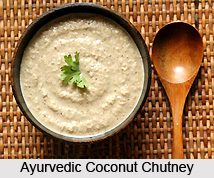 Ayurvedic Coconut Chutney is a nutritious food item consumed mainly in South India. The primary ingredients for preparing this delicious recipe comprise of ginger, coconut, chilli, coriander leaves, mustard seeds, cumin seeds, ghee, hing, salt and curry leaves. This mild dish is easy to make and can be prepared at home. It can be readied in minutes. Ayurvedic Coconut Chutney can be served with South Indian snacks like medu vada, dosas and idlis.
Ayurvedic Coconut Chutney is a nutritious food item consumed mainly in South India. The primary ingredients for preparing this delicious recipe comprise of ginger, coconut, chilli, coriander leaves, mustard seeds, cumin seeds, ghee, hing, salt and curry leaves. This mild dish is easy to make and can be prepared at home. It can be readied in minutes. Ayurvedic Coconut Chutney can be served with South Indian snacks like medu vada, dosas and idlis.
Ingredients of Ayurvedic Coconut Chutney
•One and half inch piece of fresh ginger peeled and finely chopped
•Two cups of unsweetened and shredded coconut
•Half green chilli chopped
•Two cups of water
•One tablespoon of fresh coriander leaves
•Half teaspoon of black mustard seeds
•Half teaspoon of cumin seeds
•Two tablespoon of ghee
•A pinch of hing
•Half of a fresh lime
•One-fourth teaspoon of salt
•Four fresh curry leaves
Method of Preparing Ayurvedic Coconut Chutney
•To prepare Ayurvedic coconut chutney, blend coconut along with ginger, green chilly and coriander.
•Add water and blend till it forms a smooth fine paste.
•On the other side, heat the saucepan on medium fire and add ghee, mustard seeds and cumin seeds along with hing and curry leaves. Stir gently until the seeds pop.
•Pour the spices in to the blended mixture, squeeze limejuice, stir in salt and mix it gently.
•Store in a cool place and finish it within two to three days.
Note: People with Kapha dosha can increase hing, chillies and mustard seeds.
Benefits of Ayurvedic Coconut Chutney
Ayurvedic coconut chutney is good for health as the main ingredient which is coconut is a storehouse of innumerable health benefits. Some of them are as follows:
•Coconut has cooling properties and hence good for Pitta dosha.
•Coconut can kill harmful bacteria, viruses, fungi, and parasites as it is antiviral, antifungal, antibacterial, and anti-parasitic.
•It improves immunity.
•It helps to treat illnesses such as influenza, urinary tract infections, tapeworms, herpes, gonorrhea, and bronchitis.
•Coconut can cure skin disorders such as eczema, psoriasis, and dermatitis.




















